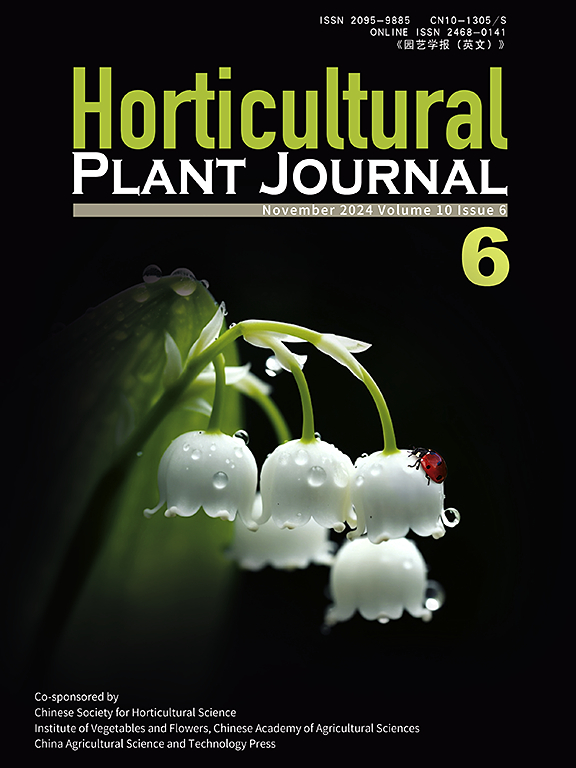通过对60个桃源品种的挥发性代谢组和转录组分析,对桃源香气的形成和相关基因的鉴定提供了新的认识
IF 6.2
1区 农林科学
Q1 HORTICULTURE
引用次数: 0
摘要
挥发性有机化合物(VOCs)是决定水果特征香气和风味的主要化学成分。本研究采用顶空固相微萃取(HS-SPME) -气相色谱-质谱联用(GC-MS)技术,从60个桃源中共鉴定出97种挥发性有机化合物,包括5C6种化合物、12种醛类、4种醇类、10种酯类、13种内酯类、18种萜烯类、8种降异戊二烯类、8种酮类、3种烃类、8种苯丙氨酸衍生物和8种其他化合物。在这些种质资源中检测到的挥发性有机化合物在数量和浓度上都很广泛。与不同生理性状的相关分析表明,遗传背景对桃品种挥发性有机化合物的组成和含量有显著影响。例如,黄桃的类去甲异戊二烯含量明显低于白桃,而石硬桃的内酯含量几乎检测不到。97种挥发性有机化合物中,有26种的气味活性值(OAVs)超过1,表明这些化合物是桃子挥发性有机化合物组成中的关键气味物质。此外,通过加权基因共表达网络分析(WGCNA)鉴定出6个与γ-癸内酯和(Z)-3-己烯酯醋酸酯合成相关的结构基因,以及5个与醛和1-辛烯-3- 1生物合成相关的基因。此外,鉴定出15个转录因子(TFs)可能调节VOC的合成。综上所述,这些数据有助于深入了解桃品种间香气品质差异的影响因素,有助于促进桃育种的发展。本文章由计算机程序翻译,如有差异,请以英文原文为准。
Combined volatile metabolome and transcriptome analysis of 60 peach cultivars provide new insights into the formation of aroma and the identification of associated genes
Volatile organic compounds (VOCs) are the main chemical compounds that determine the characteristic aroma and flavor of fruit. In this study, we identified a total of 97 VOCs, including 5C6 compounds, 12 aldehydes, 4 alcohols, 10 esters, 13 lactones, 18 terpenes, 8 norisoprenoids, 8 ketones, 3 hydrocarbons, 8 phenylalanine derivates, and 8 other compounds, in 60 peach cultivars using headspace solid-phase micro-extraction (HS-SPME) combined with gas chromatography-mass spectrophotometry (GC–MS). A wide range of VOCs were detected in these germplasm resources with respect to both quantity and concentration. Correlation analysis with different physiological traits demonstrated that the genetic background exerts a significant influence on the composition and content of VOCs among peach cultivars. For example, the content of norisoprenoid was significantly lower in yellow-fleshed peach than in white-fleshed peach, and lactones were almost undetectable in stony hard peach. Among the 97 VOCs, 26 exhibited odor activity values (OAVs) exceeding 1, suggesting that these compounds act as key odorants in the peach VOC composition. Moreover, six structural genes associated with the synthesis of γ-decalactone and (Z )-3-hexenyl acetate and five genes linked to aldehyde and 1-octen-3-one biosynthesis were identified through weighted gene co-expression network analysis (WGCNA). Additionally, 15 transcription factors (TFs) were identified as potentially regulating VOC synthesis. Overall, these data provide insight into the factors contributing to the differences in aroma qualities among peach cultivars, which can help to promote the development of peach breeding.
求助全文
通过发布文献求助,成功后即可免费获取论文全文。
去求助
来源期刊

Horticultural Plant Journal
Environmental Science-Ecology
CiteScore
9.60
自引率
14.00%
发文量
293
审稿时长
33 weeks
期刊介绍:
Horticultural Plant Journal (HPJ) is an OPEN ACCESS international journal. HPJ publishes research related to all horticultural plants, including fruits, vegetables, ornamental plants, tea plants, and medicinal plants, etc. The journal covers all aspects of horticultural crop sciences, including germplasm resources, genetics and breeding, tillage and cultivation, physiology and biochemistry, ecology, genomics, biotechnology, plant protection, postharvest processing, etc. Article types include Original research papers, Reviews, and Short communications.
 求助内容:
求助内容: 应助结果提醒方式:
应助结果提醒方式:


